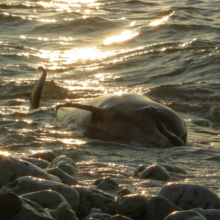Virus ‘a threat’ to endangered dolphins and whales
13 March 2019

Researchers have been investigating the evolution of cetacean morbillivirus (CeMV), to understand how the virus is able to infect multiple species of marine mammal, including dolphins, whales and porpoises.
CeMV was discovered in 1990 when a virus called dolphin morbillivirus killed over 1,000 striped dolphins in the Mediterranean Sea. In 1997, this strain crossed the species barrier and was associated with an outbreak in Mediterranean monk seals.
The symptoms of CeMV include pneumonia, brain inflammation and damage to the immune system, which usually presents as the animal having difficulty in staying afloat. Often, outbreaks of CeMV are identified by researchers following mass stranding events, where large numbers of dolphins wash up on beaches. In recent years, there has been a reported increase in stranded fin and sperm whales infected with CeMV.
Researchers from the University of Veterinary Medicine Hannover Foundation have been investigating how CeMV has evolved. The team, led by Dr Martin Ludlow, have found evidence that CeMV can spread readily between different cetacean species and that it can be carried across oceans, posing a risk to whale and dolphin populations worldwide.
“Sequencing CeMV strains in both dolphins and whales enabled us to show that minimal adaptive changes are required for virus transmission among different species, reinforcing the threat that this virus poses to endangered or vulnerable populations of dolphins and whales,” he said.
The research involved sequencing CeMV strains collected from the North Sea or Mediterranean Sea between 1988 and 2016. The researchers collaborated with wildlife biologists and veterinary pathologists to collect tissue samples from larger outbreaks as well as sporadic cases. They then used the genetic data of each virus to determine how the virus has evolved and how closely-related the cause of each outbreak were.
CeMV belongs to the genus Morbillivirus of the family Paramyxoviridae, and can infect several species of marine mammal, including whales, dolphins and porpoises. There are seven known species of virus in the Morbilliviruses family, including Measles virus and Canine distemper virus. “The mortality rate for animal morbilliviruses such as canine distemper virus is much higher than that observed for cases of measles in humans” said Dr Ludlow, “the mortality rate of CeMV is currently unknown but appears to differ between cetacean species.”
Animals could be more at risk of dying from CeMV if the population has not previously been exposed to the virus. This January, an epizootic in Brazil led to the death of over 200 Guiana dolphins. There are many dolphin populations around the world, for example white beaked dolphins in the North Sea, which show signs of previous exposure to the virus, but with less severe disease.
Dr Ludlow has also found that there is potential for the disease to cross the species barrier and ‘spill over’ into other marine mammals: “Perhaps the most interesting aspect for me about this study has been investigating the potential of CeMV to spread to non-cetacean species as infection of both seals and Eurasian otters has been documented previously.”
Dr Ludlow will present his data at the Microbiology Society Annual Conference in Belfast. His poster: ‘Evolutionary Evidence for Multi-host Transmission of Cetacean Morbillivirus’ will take place as part of the Virology Workshop: Pathogenesis and will be available to view on Wednesday evening and Thursday lunchtime. To find out more, the full research paper is available here.
Image: iStock/Ruslanshug.


